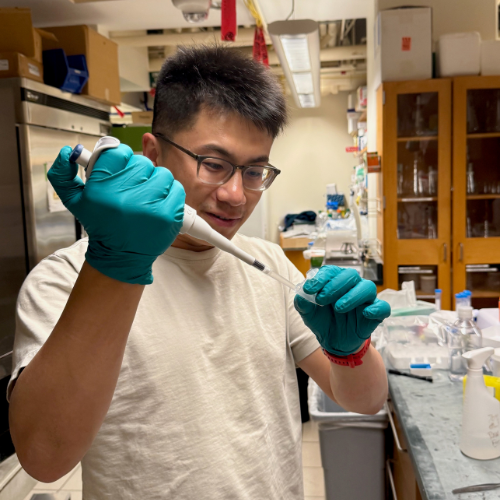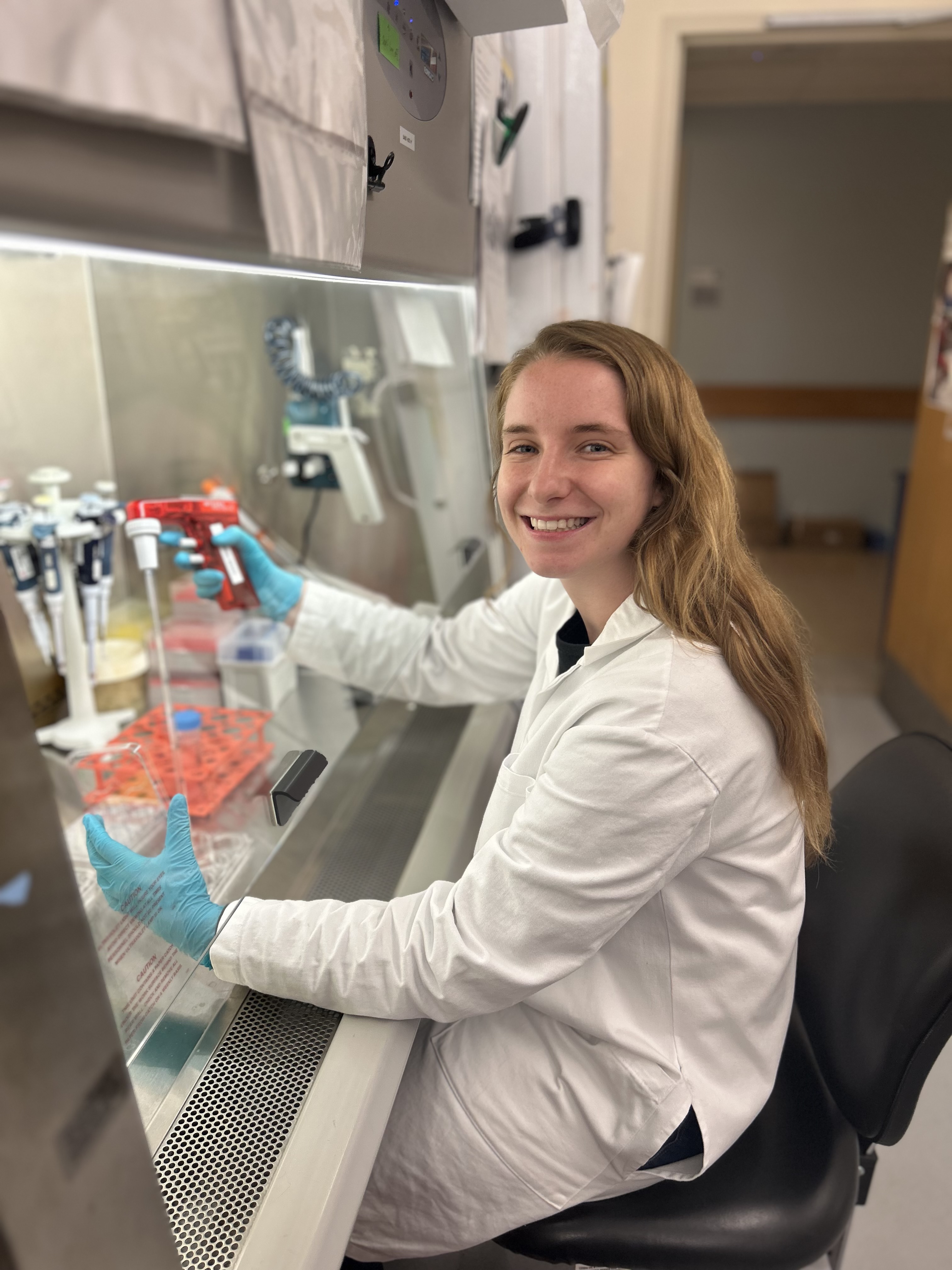Imani Williams

Imani was born and raised in Newport News, Virginia. She attended Howard University, Washington, D.C., as a first-generation college student, earning her BS in Biology with Chemistry and Psychology minors. After graduation, she was selected as a trainee for the New York Research and Mentoring for Post Baccalaureates (NY-RaMP) Program at Hunter College, New York. She worked in Dr. Jill Bargonetti’s (Damon Runyon Fellow ‘91-’94) lab, where she focused her efforts on the study of triple-negative breast cancer research and became passionate about cancer research. She is driven by the challenge of questioning conventional wisdom and exploring seemingly implausible possibilities. She is inspired by the opportunity to reshape the future of medicine, leveraging these innovations for the benefit of all patients. Imani is committed to advocating for those in need, and she believes that pursuing cancer research will allow her to make the most meaningful impact in society.
Natasha O'Brown, PhD

Glioblastoma is the most lethal primary brain tumor in adults, largely due to the blood-brain barrier (BBB), which blocks potentially effective chemotherapeutic drugs from entering the brain. Using zebrafish, Dr. O’Brown [Timmerman Traverse-Rachleff Innovator] aims to identify small molecules that can temporarily increase BBB permeability, enhancing drug delivery to brain tumors like glioblastoma and potentially improving patient outcomes. To achieve this, she will screen for small molecules that enhance BBB permeability and then validate promising candidates in mammalian systems to confirm their relevance for human use. Additionally, she will engineer “humanized” zebrafish to test advanced drug delivery methods in clinical trials. This innovative approach provides a new platform for discovering BBB-modulating therapies and paves the way for tailored treatments, offering hope for improved outcomes in aggressive brain cancers.
Rongxin Fang, PhD

Cells must communicate with each other to maintain homeostasis and respond to external stimuli. This communication typically occurs through chemical signals or via direct physical contact. Dr. Fang plans to develop genomic tools to understand how different types of cells communicate with each other in the healthy brain and how communication goes awry in brain tumors. His goal is to determine whether and to what extent it is possible to manipulate specific genes or pathways underlying cell-cell communication to reverse disease progression in brain cancer patients.
Tuyu Zheng, PhD

Ependymomas (EPN) are aggressive brain and spinal cord tumors that are especially difficult to treat in children and often come back after treatment. Recent research has shown that interactions between tumor cells and healthy neurons play a key role in EPN growth. It is not well understood, however, how exactly neurons contribute to this process. By mapping the neuronal environment and exploring the different types of neurons involved, Dr. Zheng hopes to uncover the mechanisms that drive EPN growth and find new ways to treat these tumors. Dr. Zheng received her PhD from Heidelberg University, Heidelberg, her MEng and MSc from University of Technology of Compiègne, Compiègne, and her BEng from Shanghai University, Shanghai.
Ian Blumenthal, PhD

Diffuse midline gliomas (DMG) are uniformly fatal pediatric brain cancers in desperate need of novel treatments. Immunotherapies have offered some hope to patients, but durable clinical success remains elusive, highlighting the enormous challenge of selectively targeting these recalcitrant tumors while preserving healthy tissue. Dr. Blumenthal aims to address this need by building immune cell engagers—molecules that enable a patient’s immune cells to recognize and attack their tumor—that are capable of leveraging DMG’s inherent variability and immune defense mechanisms into a therapeutic advantage. He hopes that these innovative drug designs will not only provide superior efficacy against pediatric gliomas but also pave the way for next-generation immunotherapies that better address the dynamic nature of tumor biology. Dr. Blumenthal received his PhD from the University of Washington, Seattle and his BA and BE from Dartmouth College, Hanover.
Humsa S. Venkatesh, PhD

Brain cancers are one of the most common causes of cancer-related death and represent 120 molecularly distinct diseases. Despite advances in clarifying the genetic landscape of these cancers, they remain clinically intractable, underscoring the need to elucidate the complex factors contributing to their heterogeneity. As neuronal activity is known to govern the development of neural circuits and neuroplasticity, it is critical to consider these neural networks in the context of disease. Dr. Venkatesh will use classical and systems neuroscience approaches to determine how the nervous system contributes to brain cancer progression. A comprehensive understanding of malignant neural network interactions may lead to novel therapeutic interventions aimed at normalizing the tumor microenvironment.
Costanza Lo Cascio, PhD

Pediatric diffuse midline gliomas (DMG) are incurable brain cancers with no long-term survivors. To date, radiation therapy remains the standard of care but improves survival by only a few months. Despite intense research efforts over the past four decades, there is still a lack of mechanistic understanding of the biology underlying DMG radioresistance. Dr. Lo Cascio is studying how DMG tumors exploit interactions with surrounding normal neurons to survive radiation-induced cell death. While there is ample evidence that communication between neurons and DMG cells is critical to fuel tumor growth, whether this neuron-glioma crosstalk contributes to treatment failure is unknown. Dr. Lo Cascio hopes by pushing the boundaries of our knowledge of the neuron-glioma intercellular dialogue, she can identify resistance mechanisms that can be targeted to sensitize these lethal tumors to radiation therapy. Dr. Lo Cascio received her PhD from Arizona State University, Tempe and her BS from University of Bath, Bath.
April A. Apfelbaum, PhD

Brain cancers are the leading cause of cancer-related deaths in children. A significant percentage of these tumors are classified as gliomas—diseases for which new therapies are desperately needed. A protein called tyrosine kinase FGFR1 is altered in 10% of pediatric gliomas. Dr. Apfelbaum aims to investigate critical genes in FGFR1-altered pediatric gliomas to understand the biological mechanisms driving these cancers. Her research hopes to uncover new therapeutic targets and mechanisms of FGFR1-mediated oncogenesis in pediatric gliomas, but since FGFR1 is commonly altered in many tumors, her findings may reveal a common oncogenic mechanism. Dr. Apfelbaum received her PhD from University of Michigan, Ann Arbor and her BS from Beloit College, Beloit.
John R. Prensner, MD, PhD

New therapeutic approaches are urgently needed for children suffering from high-risk medulloblastoma, a form of pediatric brain cancer, where half of children will experience disease relapse leading to death. Dr. Prensner’s [Ben and Catherine Ivy Foundation Clinical Investigator] work is focused on understanding the biological underpinnings of high-risk medulloblastoma and developing new treatment options. His team recently found that high-risk medulloblastoma may exploit an imbalance in the production of proteins from the tumor cell genetic material (RNA, DNA). Dr. Prensner aims to define the cancer biology that causes an imbalance in the protein-RNA ratio in medulloblastoma, and investigate specific therapeutic options that may target this biology. His hope is that this work leads to new options for clinical trials for children with high-risk medulloblastoma.
Wendy Xueyi Wang, PhD
Understanding how brain cells communicate at synapses—the junctions where neurons connect—is essential for understanding how the brain functions in both health and disease. Dr. Wang's [National Mah Jongg League Fellow] project aims to develop new tools to explore these intricate synaptic connections. Using spatially resolved RNA sequencing techniques, Dr. Wang can identify which genes are active in specific parts of individual neurons within intact brain slices. Additionally, she is creating novel tracers that can map neuronal connections without the toxicity and limitations of current methods. These advancements will not only enhance our understanding of normal brain development and function but also shed light on neurological disorders and brain cancers, such as gliomas, where cancer cells exploit synapses for tumor growth. This research holds the promise of revealing new therapeutic targets and strategies, potentially leading to improved treatments for various brain conditions.
